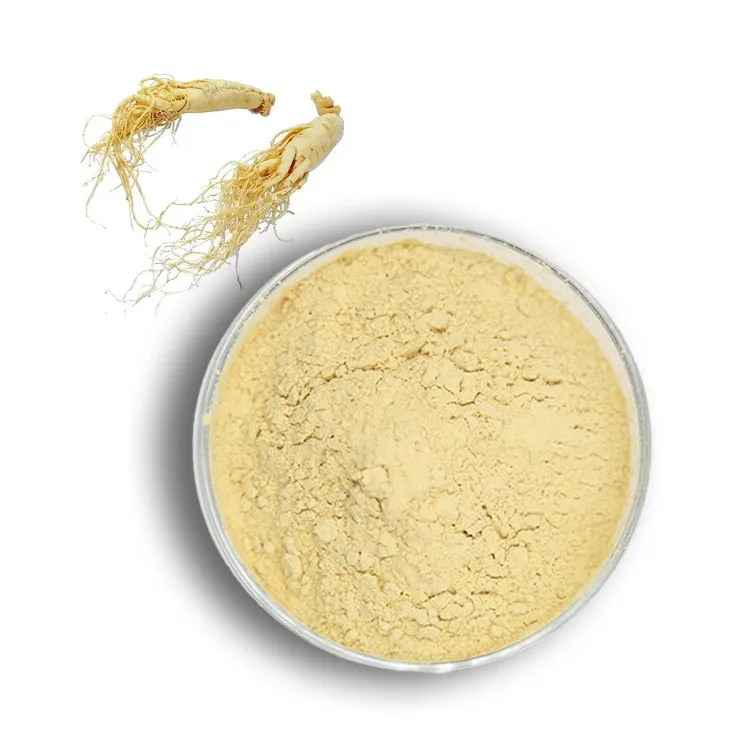- 0086-571-85302990
- sales@greenskybio.com
The process of extracting ginsenosides from ginseng root extract.
2024-11-27

1. Introduction
Ginseng has been highly regarded in traditional medicine for centuries due to its numerous health - promoting properties. Ginsenosides, the major bioactive components in ginseng, are responsible for a wide range of pharmacological activities such as anti - inflammatory, antioxidant, and anti - cancer effects. Extracting ginsenosides from Ginseng Root Extract is a crucial step in the development of ginseng - based pharmaceuticals and health products. This article will comprehensively discuss the process of extracting ginsenosides from Ginseng Root Extract.

2. Preparation of Ginseng Root Extract
2.1. Selection of Ginseng Roots
The first step in preparing the ginseng root extract is to select high - quality ginseng roots. Different species of ginseng, such as Panax ginseng, Panax quinquefolius, and Panax notoginseng, may have different ginsenoside profiles. For example, Panax ginseng is commonly used in traditional Chinese medicine and contains a rich variety of ginsenosides. The age, growth environment, and harvesting time of the ginseng roots can also affect the ginsenoside content. Generally, older ginseng roots tend to have a higher ginsenoside concentration.2.2. Pretreatment of Ginseng Roots
Once the appropriate ginseng roots are selected, they need to be pretreated. This may include cleaning to remove dirt and impurities, and drying to reduce the moisture content. Drying can be carried out using natural drying methods such as air - drying or artificial drying methods such as oven - drying. After drying, the ginseng roots are usually ground into a powder form to increase the surface area for subsequent extraction.2.3. Initial Extraction
The powdered ginseng root can be initially extracted using a suitable solvent. Solvents such as ethanol, methanol, and water are commonly used. Ethanol - water mixtures are often preferred as they can effectively dissolve ginsenosides while being relatively safe and easy to handle. The extraction can be carried out by maceration, which involves soaking the powdered ginseng root in the solvent for a certain period of time, usually several hours to days. Another method is percolation, where the solvent is continuously passed through the powdered ginseng root.
3. Extraction Methods
3.1. Ultrasonic - Assisted Extraction
Ultrasonic - assisted extraction is a popular method for enhancing the extraction rate of ginsenosides. Ultrasonic waves can create cavitation bubbles in the solvent, which collapse and generate high - pressure and high - temperature micro - environments. These micro - environments can break the cell walls of the ginseng root cells more effectively, thus facilitating the release of ginsenosides into the solvent. The ultrasonic - assisted extraction process usually requires an ultrasonic generator and a suitable extraction vessel. The extraction time, ultrasonic power, and solvent - to - sample ratio are important parameters that need to be optimized. For example, a higher ultrasonic power may lead to a higher extraction rate, but it may also cause the degradation of ginsenosides if the power is too high.3.2. Supercritical Fluid Extraction
Supercritical fluid extraction (SFE) is another advanced extraction method. Supercritical fluids, such as supercritical carbon dioxide (sc - CO₂), have properties between those of a gas and a liquid. They can penetrate into the pores of the ginseng root material more easily and have a high solvation power for ginsenosides. SFE has several advantages, including a relatively short extraction time, low solvent consumption, and the ability to obtain a relatively pure extract. However, the equipment for SFE is relatively expensive, and the process requires precise control of parameters such as pressure and temperature.3.3. Microwave - Assisted Extraction
Microwave - assisted extraction (MAE) utilizes microwaves to heat the solvent and the ginseng root material. Microwaves can cause the polar molecules in the solvent and the ginseng root cells to vibrate rapidly, generating heat. This heat can disrupt the cell membranes and accelerate the extraction of ginsenosides. Similar to ultrasonic - assisted extraction, the parameters such as microwave power, extraction time, and solvent - to - sample ratio need to be optimized in MAE. MAE has the advantages of fast extraction speed and high efficiency, but it also requires careful control to avoid over - heating and degradation of ginsenosides.
4. Refinement of the Extract
4.1. Filtration
After the extraction process, the obtained extract contains not only ginsenosides but also other impurities such as cell debris, proteins, and undissolved solids. Filtration is the first step in refining the extract. There are various filtration methods, including simple gravity filtration using filter paper or more advanced membrane filtration techniques. Membrane filtration can be further divided into microfiltration, ultrafiltration, and nanofiltration, depending on the pore size of the membrane. Microfiltration can remove larger particles such as cell debris, while ultrafiltration can separate proteins and other macromolecules from the ginsenoside - containing solution.4.2. Concentration
The filtered extract usually has a relatively low concentration of ginsenosides. Concentration is required to increase the ginsenoside content. This can be achieved by methods such as rotary evaporation or vacuum evaporation. Rotary evaporation involves rotating the flask containing the extract under reduced pressure, which causes the solvent to evaporate at a lower temperature, thus concentrating the ginsenosides. Vacuum evaporation uses a vacuum system to lower the boiling point of the solvent and accelerate the evaporation process.4.3. Separation
To obtain pure ginsenosides, further separation steps are necessary. Chromatographic techniques are commonly used for separation. High - performance liquid chromatography (HPLC) is a powerful tool for separating and purifying ginsenosides. It can separate different ginsenoside components based on their different affinities for the stationary phase and the mobile phase. Another chromatographic method is column chromatography, which can be used for preparative - scale separation of ginsenosides. Ion - exchange chromatography can also be applied to separate ginsenosides based on their charge properties.
5. Quality Control and Analysis
5.1. Identification of Ginsenosides
In order to ensure the quality of the extracted ginsenosides, identification is necessary. There are several methods for identifying ginsenosides. Thin - layer chromatography (TLC) can be used as a simple and rapid screening method. TLC plates are coated with a stationary phase, and the sample is spotted on the plate. After development with a suitable mobile phase, the ginsenosides can be visualized under ultraviolet light or by staining. However, TLC has relatively low resolution. HPLC is more accurate and can provide detailed information about the types and quantities of ginsenosides. Mass spectrometry (MS) can be coupled with HPLC to further identify the molecular structures of ginsenosides.5.2. Quantification of Ginsenosides
Quantifying the ginsenosides is important for quality control. HPLC can be used for quantification as well. By comparing the peak areas of the ginsenoside standards with those of the samples, the content of ginsenosides in the extract can be determined. Enzyme - linked immunosorbent assay (ELISA) is another method that can be used for the quantification of specific ginsenosides. However, ELISA may be less accurate for complex mixtures of ginsenosides.5.3. Purity Assessment
Purity assessment of the extracted ginsenosides is crucial. In addition to chromatographic methods for separation and identification, spectroscopic methods can also be used for purity assessment. Ultraviolet - visible (UV - Vis) spectroscopy can be used to detect impurities that may absorb light in the UV - Vis region. Infrared (IR) spectroscopy can provide information about the functional groups in the ginsenoside molecules and can also be used to detect the presence of impurities. Nuclear magnetic resonance (NMR) spectroscopy is a more powerful tool for determining the molecular structure and purity of ginsenosides.
6. Conclusion
The process of extracting ginsenosides from ginseng root extract is a complex and multi - step process. It involves the preparation of the ginseng root extract, selection of appropriate extraction methods, refinement of the extract, and quality control and analysis. Each step is crucial for obtaining high - quality ginsenosides. With the continuous development of extraction and analysis techniques, it is expected that more efficient and accurate methods for ginsenoside extraction will be developed in the future, which will further promote the development of ginseng - based pharmaceuticals and health products.
FAQ:
1. What are the main pharmacological activities of ginsenosides?
Ginsenosides have a variety of pharmacological activities, such as anti - inflammatory, antioxidant, anti - tumor, immunomodulatory, and cardiovascular protection. These activities make ginsenosides important components in the development of pharmaceuticals and health products.
2. Why is ultrasonic - assisted extraction used in the process of ginsenoside extraction?
Ultrasonic - assisted extraction can enhance the extraction rate of ginsenosides. The ultrasonic waves can cause cavitation and mechanical effects in the extraction solvent, which can break the cell walls of ginseng root cells more effectively, thus releasing more ginsenosides into the solvent.
3. What are the key steps in refining the obtained ginseng root extract to obtain pure ginsenosides?
The key steps in refining the extract to obtain pure ginsenosides may include filtration to remove solid impurities, concentration to increase the content of ginsenosides in the solution, and further separation steps such as chromatography to separate ginsenosides from other components in the extract.
4. How does the quality of ginseng root affect the extraction of ginsenosides?
The quality of ginseng root has a significant impact on the extraction of ginsenosides. High - quality ginseng root with a higher content of ginsenosides will result in a higher yield of ginsenoside extraction. Factors such as the origin, growth conditions, and harvesting time of ginseng root can affect its quality and, consequently, the extraction of ginsenosides.
5. What are the challenges in the process of ginsenoside extraction from ginseng root extract?
Some of the challenges in the process of ginsenoside extraction include the complexity of the composition of ginseng root extract, which makes it difficult to achieve high - purity extraction. The extraction efficiency may also be affected by factors such as the choice of extraction solvent and extraction method. Additionally, ensuring the stability and bioactivity of ginsenosides during the extraction and refining process is also a challenge.
Related literature
- Optimization of Ginsenoside Extraction from Ginseng Root by Response Surface Methodology"
- "Comparative Study of Different Extraction Methods for Ginsenosides from Ginseng"
- "Recent Advances in the Pharmacological Activities of Ginsenosides"
- ▶ Hesperidin
- ▶ citrus bioflavonoids
- ▶ plant extract
- ▶ lycopene
- ▶ Diosmin
- ▶ Grape seed extract
- ▶ Sea buckthorn Juice Powder
- ▶ Beetroot powder
- ▶ Hops Extract
- ▶ Artichoke Extract
- ▶ Reishi mushroom extract
- ▶ Astaxanthin
- ▶ Green Tea Extract
- ▶ Curcumin Extract
- ▶ Horse Chestnut Extract
- ▶ Other Problems
- ▶ Boswellia Serrata Extract
- ▶ Resveratrol Extract
- ▶ Marigold Extract
- ▶ Grape Leaf Extract
- ▶ blog3
- ▶ blog4
-
Chinese Oyster Peptide Powder Factories.
2024-11-27
-
The best organic L - carnitine.
2024-11-27
-
Certified organic acerola cherry extract.
2024-11-27
-
Wholesale β - carotene suppliers.
2024-11-27
-
Chinese lemon balm extract factories.
2024-11-27
-
100% Pure Organic Bitter Melon Extract.
2024-11-27
-
100% Pure Natural Yellow Pine Extract.
2024-11-27
-
Natural grape seed extract
2024-11-27
-
Cranberry Extract
2024-11-27
-
Giant Knotweed Extract
2024-11-27
-
Fig Extract
2024-11-27
-
Cat Claw Extract
2024-11-27
-
Purple Sweet Potato Extract
2024-11-27
-
Astaxanthin
2024-11-27
-
American Ginseng Root Extract
2024-11-27
-
Artichoke Extract
2024-11-27
-
Hawthorn powder
2024-11-27





















